Satsang in Nepal: July 2023 | Mohanji
Invaluable knowledge gained from the satsang
Mohanji: A student went to Rumi and asked, “What should I do?” “Throw your books in the river and come back.” Outside knowledge is a trap. Here, we’re filled with knowledge, but what happens eventually is that we’re stuck with knowledge. Even Kundalini experiences – thousands of books. When they have experiences, people say, “Hey, this wasn’t in the book. This isn’t right.” Our experience is our own – nobody else can tell you.
You’re a constitution, a complete universe. Your experience is yours. Nobody else can say this is right or wrong. This is true – for you. Another person’s experience is another person’s, and that’s true for them. How can we say this is right or this is wrong? That’s only at the mind level. At the consciousness level, nothing is right or nothing is wrong. That’s how it is. The good, bad and the ugly have the same energy inside. That’s the point. Are you with me? Do you understand? Good question. Thank you.
Witnesshood, self-realisation and God-realisation
Question: Guruji, pranaam. We’d like to know what’s the difference between self-realisation and witnessing.
Mohanji: Witnesshood or witnessing is the state of your aatma (soul). For example, look at this light bulb. There’s electricity inside, but do we see electricity? Or do we care? If the electricity isn’t there, we’ll say, “Electricity isn’t there”, but while going through the bulb, we only see the light. We don’t even look at the bulb. This is the state of electricity, whether it goes through the bulb or it goes on to the air conditioner where it’s the same – where it’s channelled, it’ll go through that.
That’s the state of witnesshood. Whatever is happening, you’re still the same. There’s no expectation; there’s no disappointment. There’s no high or low. They’re always the same; you’re witnessing. The eyes are seeing, but you’re connecting to the thing that makes the eyes. That’s the awareness you have. You’re hearing, but you’re connected to what makes your ears function, and it stops when you’re sleeping. You’re always connected to the thing that’s making you function but not interested in the result. That’s witnesshood. Now, self-realization: this constant witnesshood takes you to turiya state.
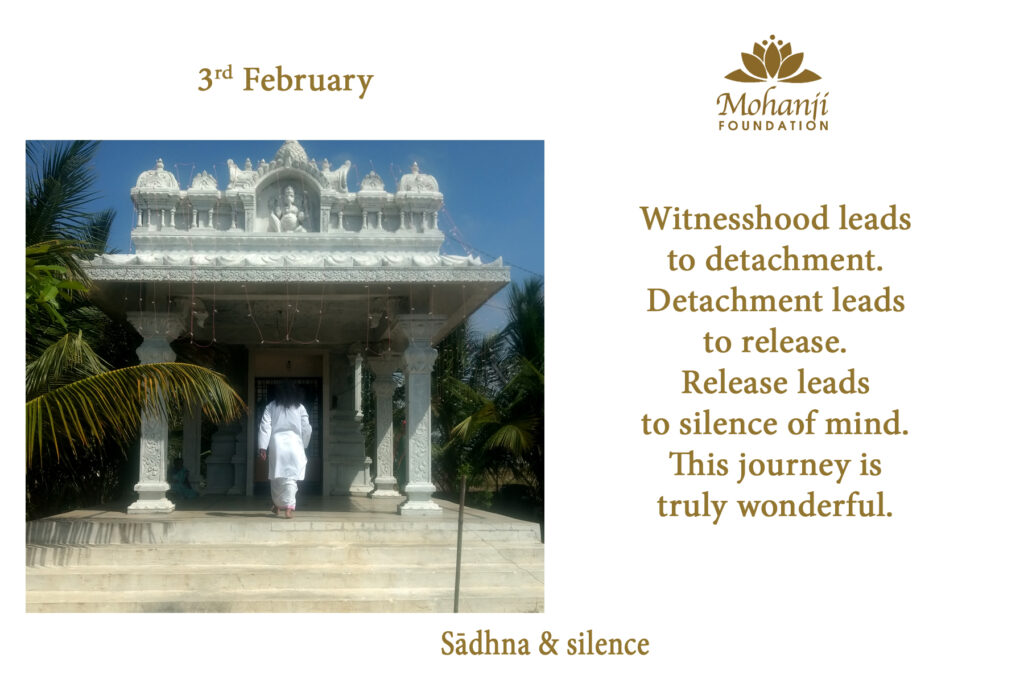
See, first there are gunas. Tamo guna (state of inertia) is a state where we’re completely lazy, procrastinating – going through the same situations. We don’t have any initiative. Then rajo guna, where you’ve action, but you’ve expectation. It’s not pure action. You’ve action; you’re constantly busy doing things, but for something – for something with expectation. That’s rajo guna.
Then sattva guna – you’ve action but no expectation; that’s pure. So, we’re these three levels. But sattva guna is not always stable because we’ve been trained at school to maintain rajo guna or tamo guna. That’s what sells well. If you’ve got a lot of tamo guna, you’ll be in the bar or a pub. So, these are the three levels. Why is it important to be with a guru? Because a guru will never allow you to be in tamo guna. He’ll kick, “Come on; get up; do it.” He will not even allow you to be in rajo guna – action with expectations. If you’ve expectations, he’ll kill it. Then, what he can do is that you’re always in sattva guna. You’ll be in high action, but no expectations.
From there comes turiya, the state beyond these; that’s witnesshood. When you’re in witnesshood and realise that you’re the witness all the time, you become that. Where you park your mind, that becomes you. That’s what Hanumanji did, right? He parked his mind in Rama, at Lord Rama’s feet. What he did was he parked his mind completely at Rama’s feet, and he attained ashta siddhis (the eight powers) and nava nidhis (the nine treasures). Where did that come from? Just by being stable in one place, fully knowing that, ‘This is consciousness. This is God; this is an avatar.’ He understood that Rama was an avatar, so he just parked his mind there.
Many gurus who’ve taken people to higher levels didn’t give anything to the disciples. They gave themselves – ‘You can use this in whatever way you can’. This is our path of Raja Yoga. If you read the book, Mast, the student was with the teacher long enough to dry himself up. All his desires dried up, and the guru gave himself to the disciple. The disciple came to the same state as the guru. This is how it is. We realise that the sukshma (the subtle) is what drives the machine, and the sthoola, the gross, is the machine.
It’s like the light bulb that doesn’t work without electricity; we’re the electricity. When we understand this and experience it for ourselves, then we become self-realised. When we go further, when we see beyond us and see that ‘Everything is me’, this is what we see. When we look outside and see a bird, ‘That’s all me’. You can’t see a difference. It’s like a toy – another body. ‘Inside is me!’ That tree, plant, everything – ‘Hey, inside is me!’
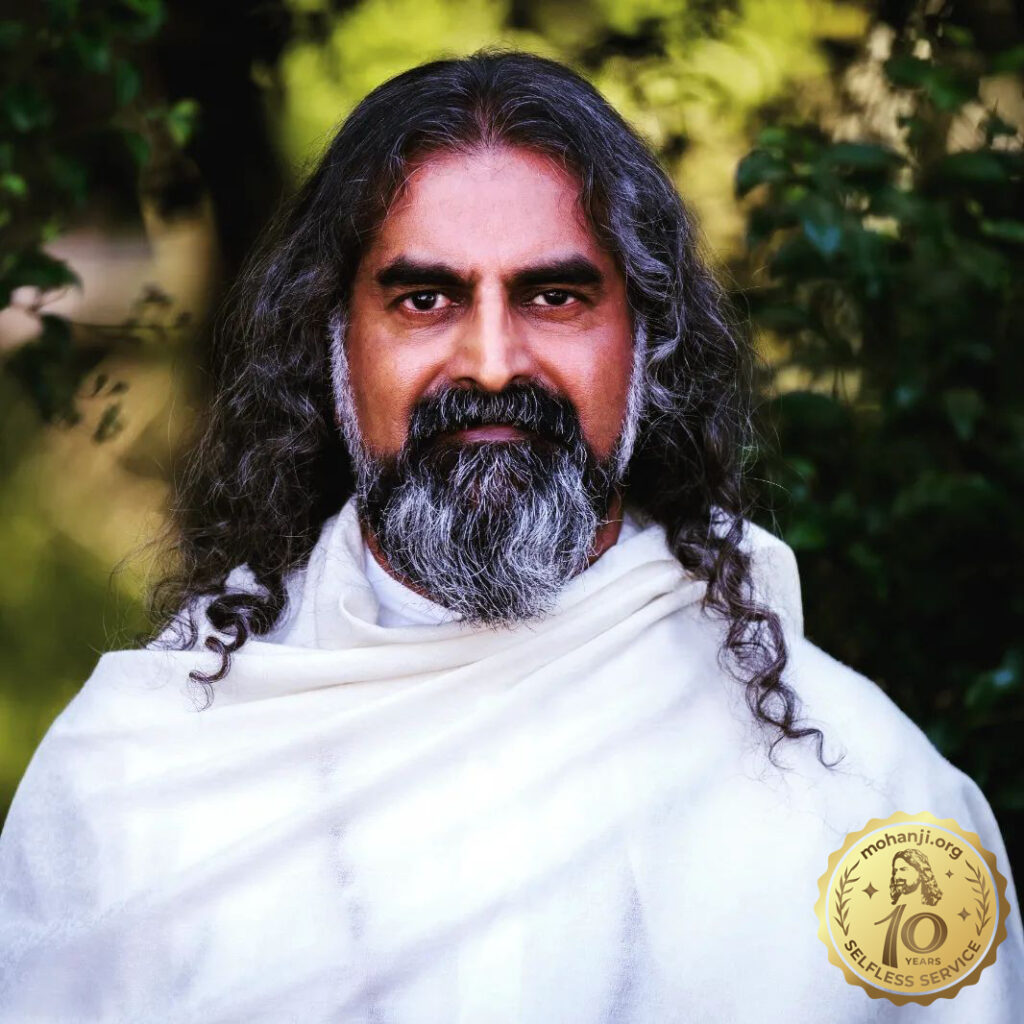
Many gurus who’ve taken people to higher levels didn’t give anything to the disciples. They gave themselves – ‘You can use this in whatever way you can’. This is our path of Raja Yoga.
– Mohanji
How can you see a difference? By looking at personality, you’ll not be affected. Different people, different personalities; that’s okay. We’ll not be affected. Why? ‘Because that’s me!’ You aren’t affected by your right hand or left hand, right? It’ll be like that. The whole of creation is your body, not in the physical sense but in the subtle sense. In the subtle realm, you’re in everything. When you start feeling that continuously, you become God-realised. Then, there’s no conflict with anyone. There’s no feeling of give and take. There’s only peace, eternal peace; there’s no mind. In the fourth state of samadhi, the mind is lost. After the fourth stage of samadhi, there’s no possibility of reverting back to the previous stage. There’s no mind.
What had supported the mind? Thoughts. Now, there are no thoughts or language. Thoughts were holding the mind. The pillars of the mind were thoughts. Now, the pillars are gone, and the mind collapses. Then nirvikalpa samadhi, and all that stuff. But in the fourth stage of samadhi itself, Patanjali has said this beautifully – the mind is finished. It’s beautiful, isn’t it?
Audience member: Namaste Guruji. First of all, I would like to give you a warm welcome to our country, to Nepal, on behalf of all the Nepali people.
Mohanji: Thank you.
Audience member: I really appreciate what your ideas have been doing all over the world. I was also lucky to be part of your volunteering acts. I was involved in some tree plantations and some donations, like food distribution. It was really a privilege.
Mohanji: I watched you; I know you. I keep an eye. You’re doing a wonderful job. I’m really proud of you.
The significance of Shiva
Question: Thank you. My question is – being the young generation, how can we define or understand Shiva? Who is Shiva? Is he a form, or is he formless? Is he in a temple, or is he everywhere? Being the young generation, being newcomers, how can we understand Shiva?
Mohanji: I’ll give you a very easy reply. Nobody can understand Shiva (laughter). I’ll explain more, but first, I’ll come to the first part. Why do we perform seva? Karma yoga is for purification. When we give something or share something with society, we’re purifying ourselves.
Karma yoga is fundamentally for purificatioṇ. When you’re pure, and you’re working without expectations, selflessly, automatically, you’re in sattva guna. That’s the highest you can achieve in one lifetime. The turiya state happens to you. You cannot make that – with your actions, you cannot be there. Only through beingness can you reach turiya, but you reach sattva guna with your activities. When your activity is pure, when your activity is selfless, when you’re selflessness, then sattva guna happens.
Now, the next part. When you’re in sattva for long enough, when you don’t need anything from society, but you’re giving everything to society, then what happens? You have no separation from the society. You become one with the society. Then you start knowing Shiva.
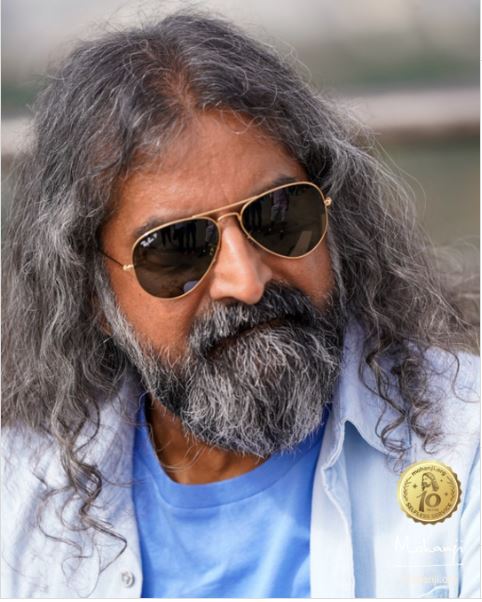
When you’re pure, and you’re working without expectations, selflessly, automatically, you’re in sattva guna. That’s the highest you can achieve in one lifetime. The turiya state happens to you. You cannot make that – with your actions, you cannot be there. Only through beingness can you reach turiya, but you reach sattva guna with your activities.
– Mohanji
Do you know what I mean? When you’re selfless, sharing what you have and living a life of complete surrender and selflessness, you automatically lose separation from society. If somebody is crying, you’ll feel the pain. If somebody is happy, you’ll feel happiness. It means your body is expanded. Your personality is expanded in society; everybody is you. Then you start experiencing, somewhat like a small taste – one drop of honey on the tongue, what is Shiva.
Then you still continue to do that, and you don’t even know you. Like he was singing a song – so beautiful, powerful, and what happens? It melts you. You feel that you don’t exist. It’s just the song existing. The singer becomes the song, right? The man becomes the music. There’s no separation between the singer and the song. Like that, there’s no separation between you and the society. There’s no separation between your bhaav (emotion)and the society’s bhaav. Then, you become more and more aware of the stillness factor. That’s somewhat Shiva, a little bit like Shiva.
Shiva is well beyond form. Why the Shiva Linga? You look at all the atomic reservoirs of the world, atomic storage in the world. It’s all in Shiva Linga form in any country you take. Why that form? Because that’s the form which can contain great energy, great power. Shiva is a great energy, great power. We’re like a small atom. Trying to understand that, all you can do is to become that. Now, you cannot understand it; it’s unknowable. You cannot know Shiva, but you can become that; you can become Shiva. This atom becomes the universe; raw energy, the universe, and you become Shiva.
Then, do you understand Shiva? There’s nothing to understand. That’s why Muruga told Shiva who he was. Muruga, his son, told Shiva, his father, the meaning of the sound Om. The father is Omkar already. See, nobody can tell me what is Mohanji, right? I wouldn’t understand. People tell me, “You are Mohanji”. Okay, I believe it. But ‘What is Mohanji?’ if I’m in that state already, there’s no way I can understand it. So, Shiva didn’t understand it. Lord Muruga, Lord Kartikeya, told Shiva what was Omkar – the energy. One of Shiva’s names is Naadasvaroopa; he’s the sound. The body is of sound; he’s that already. So, somebody said, “Hey, look here, you’re this.”
Hanumanji also experienced the same thing, right? When he reached the edge of India and realised that Sita was sitting on an island, he lost courage. ‘I won’t be able to go any further. This is it.’ Then Jambavan and all these people said, “Hey, you are Hanuman! Come on! You are powerful! You had gone to catch the sun one time.” Then Hanuman understood; he could do it. Everybody, at some point in time, feels that they don’t know who they are. Then somebody can tell them. Muruga explained to Shiva, “Father, you’re all these things. Everything is you.” “Oh, really! Okay.” This is how it is.
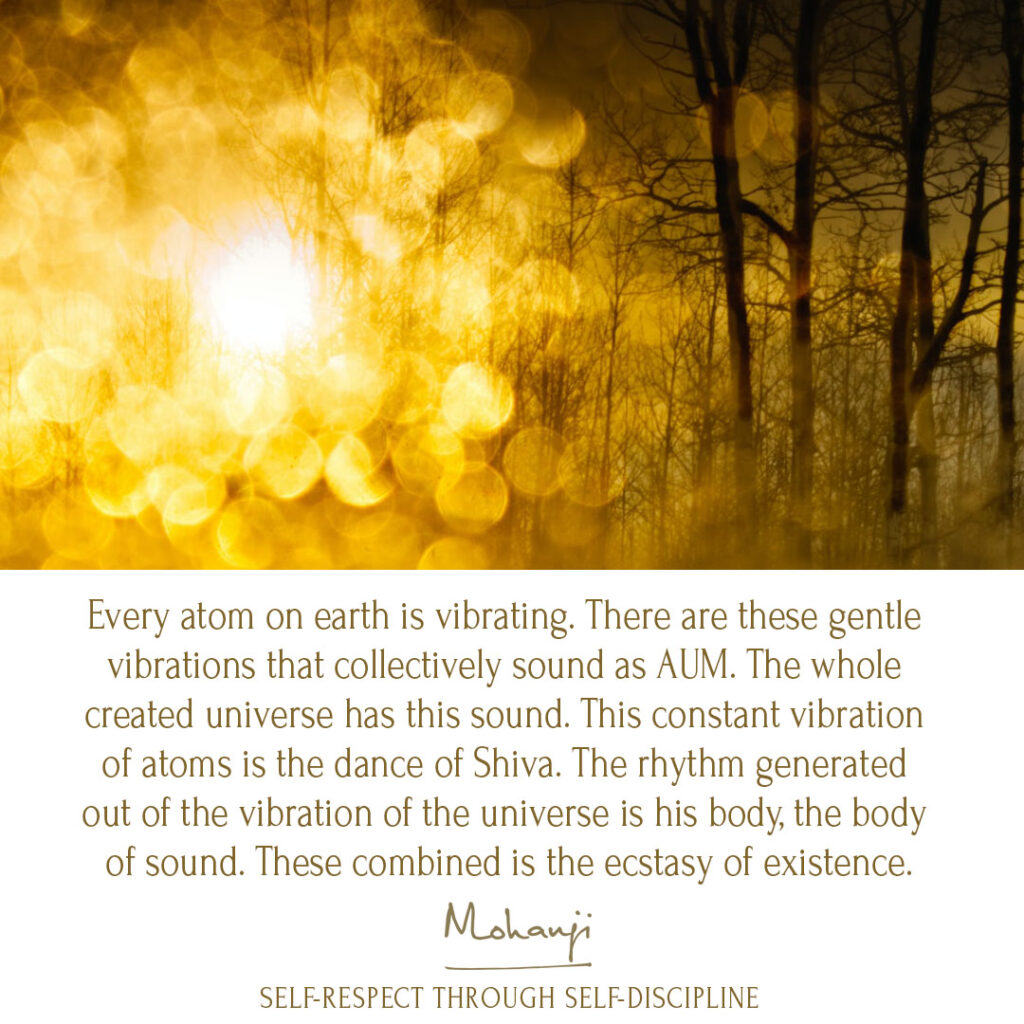
So, to know Shiva intellectually, forget it. Be Shiva! It’s perfectly possible, and one lifetime is enough. The path is very good – seva, where you don’t exist. Society exists, and through you, you see everything in society functioning outside of you and inside of you – Karma Yoga. Karma Yoga is beautiful.
The importance of annadaan (food donation)
Through annadaan (food donation), how many things have changed in the world, you know. Food is given to fishes, beings of the water. The body is filled with water, right? What’s our body? Water. When we feed the fish, so many things change inside us. Our energy changes inside. Second, to the birds in the sky. A part of us is sky and air. So, when we give food to the birds, the sky and the air, our insides are purified, the elements inside. The body is of elements: earth, water, fire and air. Then we do homas; we purify our fire. Fire is already pure. You cannot purify fire, but then it activates the fire aspect of us.
Then, to our species. What’s that for? We give food to people; what are people representing? Our own ancestors – our father’s side and mother’s side. So many people have lived; hundreds and thousands of people have lived in our family, and you’re the current representative of that family. So, when you take care of all the people, the sick and the old and the children, you’re automatically purified. Your lineage is purified. So many people are getting benefitted! That takes you to Shiva, to the state of Shiva. Shiva is a state (stillness).
Shiva and Shakti
Okay, let me ask you one question. Shiva is a state, and he has nothing. Then why did he become angry when Shakti died? He isn’t anger; he is calmness, stillness. Do you know why? What’s Shakti? Shiva’s expression. Shiva is stillness: Satyam, Shivam, Sundaram, Shantam.
What’s Shakti? The action side, the energy, the movement, the action. In our body itself, what are the movements? Prana, apaana, vyaana, udaana, samaana – these five functional pranas are moving in the body. That’s what is maintaining your physical existence. This is activated by Shakti – Kundalini Shakti. This is making creation. Shakti is the source of creation. Shakti is the activator; because of that, there’s creation.
When Shakti left Shiva, Shiva had no expression. Shiva is pure brightness and stillness; then, there’s no world or universe. He said, “Okay, Shakti isn’t there; I don’t need the world. So, he plucked his jata (matted hair) and slammed it on the floor. Fire came, and there came Maha Kali and Veerabhadra. What did they ask Shiva? “What should we do?” Shiva said, “Destroy. Destroy everything.” What did they do? They went and destroyed. Why did he want to destroy? Because if you can’t create, why do you need a platform? A platform is for creation, existence, and experience. If that’s not possible, then why do we need it?
Later, Parvati came, and the whole thing restarted. If you look at most of the texts, Shiva Sutras and all these things, it’s all conversations between Shiva and Parvati. Shiva is the source (the knowledge), and knowledge is represented by Muruga (Kartikeya). The other side is Lord Ganesha – pure awareness of consciousness. So, pure awareness of consciousness and knowledge of the source. They’re the two sons, and Parvati is the Shakti. This is the combination – Shiva parivaar (the Shiva family). This is beautiful.
Audience member: Thank you for enlightening us. Thank you.
The right path for us
Question: Sai Ram Guruji. My question is, how do I know what’s my path? Which way is for me to reach the highest? We had a meditation before this session. I meditated after a long time, and it was a great experience.
Mohanji: All our meditations are free on the internet. You can download it and practise.
Question: Which path is for me? Is it the path of action or the path of contemplation?
Mohanji: Okay. How did you buy this shirt that you are wearing?
Audience member: It was gifted to me.
Mohanji: Okay, but why are you wearing it? It suits you, right? It fits you.
Audience member: This is what I have.
Mohanji: If you wear something that cannot fit you, you’ll not wear it, right? If it’s half the size, can you wear it? It’s very simple; our path chooses us. The path that comes to you, which suits you, that’s what is good for you. We don’t choose the path, like you’re sitting in school, and a teacher comes to your class. You didn’t choose the teacher, right? The teacher came to your class, taught you and took you to the next class. It’s like that; the path is always effortless. What’s effortless for you is the right path.
Suppose you have to put effort into being on a path that’s not your path. Effort means, “Oh! I have to get up, do this, sadhana, etc.” That’s not the path. The path that automatically happens in you, which takes you all the way forward and will be effortless like a flowing river, you love to do it. Some people do Karma Yoga, very pure action, selfless action, and when selfishness comes in there, automatically, it’s lost.
Do you know the story of Narada and the king?
Narada came to the king, and the king asked, “I want to attain liberation. How can I do that in this life?”
Narada said, “Make sure nobody in your country sleeps hungry.” Nobody is hungry; very simple. Everybody eats food before they sleep. The king said, “That’s easy; I’ll do it.” He sent all the soldiers to all the places and made sure everybody had food to eat; all people were eating food. Then he made sure they came back and told him it was done. So, the team came back, and the soldiers came back and said, “100,875 people were hungry in your country. We’ve given them food.”, and this continued.

The next time Narada came, the king said, “Swami, as you said, I’m feeding all the people in the country. Nobody is sleeping hungry. One hundred thousand eight hundred seventy-five people are given food every day. Now, will I get moksha? Will I attain liberation?” Narada said, “No”. The king said, “Why? I followed what you said.” Narada replied, “No, you counted. That’s not selfless action. Action, when you count it and have an expectation, becomes impure.“
If I already tell you something with an expectation, there’s a condition; it’s impure. When I need nothing from you, and I’m giving what I have to you, it’s pure. So, ensure that you have pure action at least to some point each day. That’ll give you clarity; automatically, you’ll know. To know your own path is very easy as that’s effortless for you.
That’s why some people, for example, a person who is bhakti oriented – chanting, singing and praising God, and then they dissolve in God, that’s good for them, as their orientation is there. Otherwise, they can’t do it, right?
You tell a Jnana Yogi, a man who likes information, knowledge, and analysis, to sing every day Lord’s praises; he won’t do it. He can’t do it. Why? Because that’s not the orientation; that’s not the constitution. You can only do as per your constitution, and when you do as per your constitution, it’ll shift you so fast that you’ll be surprised by the speed. Only one reason – it suits you! You’re wearing the shirt because it suits you; it’s your size. If it’s half your size, even if you try, you won’t be comfortable like that.
You don’t have to choose a path. The path chooses you, and how do you know? It’s effortless and easy for you. Everybody has their orientation, right? Some of you, some people like ISKCON and Krishna consciousness, and they are Bhakti Yogis; they chant and sing and are ecstatic in their practices. We walk the path of Raja Yoga. It’s connecting to consciousness. It’s not even the self-realization path. Self-realization is one part of it, of becoming Shiva. I’ll tell you one experience of mine. This is also connected to the earlier question.
We were climbing the Inner Kora, going to the Inner Kora – very tough climbing by rope, etc. (Kailash 2016). By the time I reached the top, it was exhausting because it was 32,000 feet or something very high and tiring and less oxygen. By the time you reach there, it’s very tiring. So, I decided to lie down with my head towards Kailash. I was wearing a bandana covering my face and lips. Everything was covered, and my head was covered. I was lying down.
Suddenly, I had a stone in my mouth. It’s impossible to have had the stone in my mouth because my whole face was covered. Then I heard a voice, “Get up. Don’t lie down here. If you lie down, you won’t be able to go back. Get up.” Immediately, I jumped up and asked, “Who’s speaking?”
Then they said, “We have done tapas here for thousands of years to have darshan of Shiva, but we won’t ask for it. Why don’t we ask? If we ask for the darshan of Shiva, Shiva will ask, “I’ll come to you. In which form do you want to see me? How should I come?” You’ll say whichever form you know, and then it takes thousands of years to erase that form to connect to the real Shiva, who is formless. So, it’s very important that we don’t ask; instead, we become. Then everything comes to you.
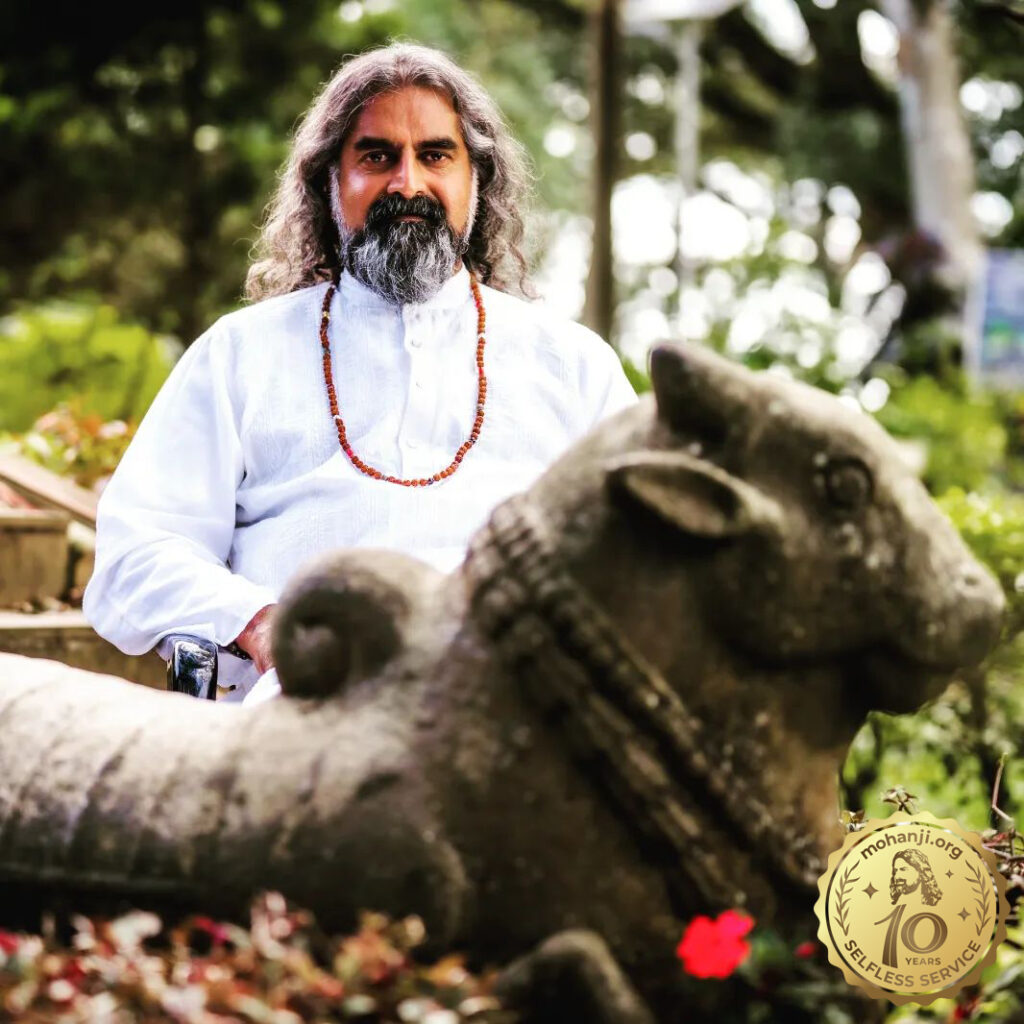
You don’t have to choose a path. The path chooses you, and how do you know? It’s effortless and easy for you.
– Mohanji
All things happen to you. All you have to do in the path of Raja Yoga is be available. Just walk it; be available. Just walk it, accept yourself, and ‘be you’ all the time. Everything comes, the state comes, and all the things come. But if you think, “Okay, this is another path, that’s different. This is a different thing.” If you keep shifting, what happens? The mind is controlling you.
The impact of patterns on our life
Please remember; we’re controlled by patterns. Patterns have pushed your birth. Life after life after life, we’re controlled by patterns. A pattern means inclinations, desires, tendencies, and all the features of our life; they’re all connected to patterns. Patterns rule us; breaking the pattern isn’t easy. The pattern is waiting for you.
This whole spiritual journey is a movement – one shore is sthula (gross), and the other shore is sukshma (subtle). When you start moving towards the subtle more and more, you start becoming liberated more and more. The journey is very simple: more and more awareness of the sukshma or the subtle. When that happens, automatically, enlightenment happens. Then, you have to wait until you become the ocean – the consciousness. There, if you don’t have a body, then there’s no time. Only with a body we’re bound by time.
Patterns cannot hold you if you’re not bound by time. Patterns hold you when you’re bound by time, right? I asked the question now. Are you hungry? That’s bound by time. What tells you that you’re hungry? Mostly the clock, not your stomach. How many of us decide on hunger based on our stomachs? Very few, right? Most of us think, “Oh, it’s time for dinner.” We didn’t ask the stomach, “Are you hungry?” This is exactly how we live, right? We’re bound by time. Patterns are bound by time. Life is bound by time – existence, birth and death are all bound by time. So, this has to be very clear.
You’re not following any path; the path follows you. You’re just looking into yourself, and what suits you is your path. The Guru is also like that; you’re not choosing any guru. The Upanishad says that the one who appeared in your life is your Guru. The one who has come to you was sent. But we have a mind – our Guru should look like Sai Baba; our Guru should look like Babaji. This is our mind. But what’s the truth? The truth says what suits you comes to you.
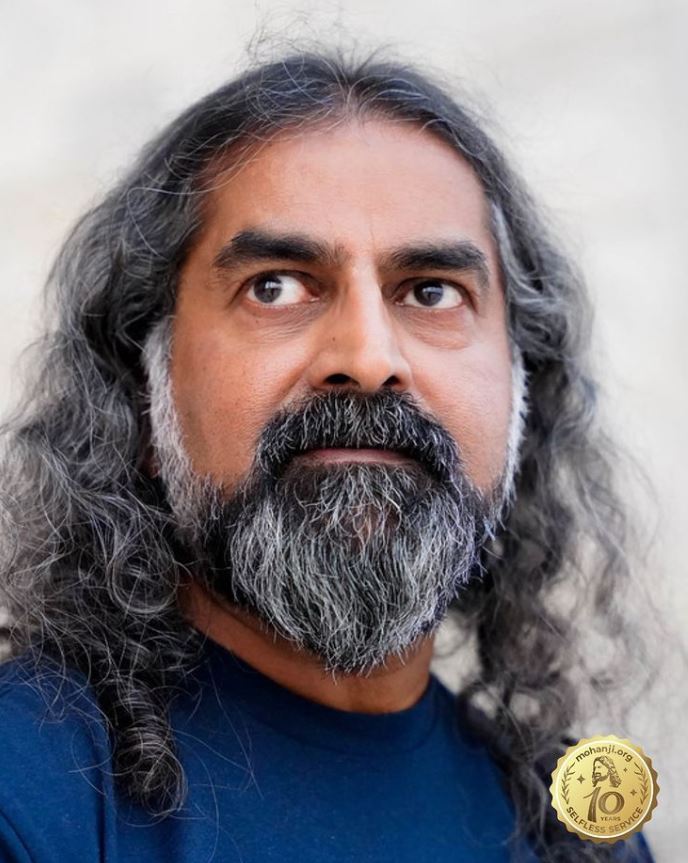
This whole spiritual journey is a movement – one shore is sthula (gross), and the other shore is sukshma (subtle). When you start moving towards the subtle more and more, you start becoming liberated more and more.
– Mohanji
In our school, we were sitting in class and didn’t choose the teacher. The teacher came, and then we realized this teacher would take us to the next class. That level of connection to yourself is important. All you need is a connection with yourself. Then everything comes one by one. I can explain this subject much more when we have more time. It’s already very late. So, I don’t want to go deeper and deeper. But did you understand what I said? You’ll know what’s right for you when you know that this is what you want.
Spirituality and technology
Question: I would like to ask how we can balance spirituality and technology. Highly influenced by technology, is it possible that we can be spiritually free?
Mohanji: Let anything happen outside of you; you cannot control technology, and no need to control it because now it’s a virtual world. Our main relationship in this life is with our mobile phone. Who do we spend the most time in the day with? Mobile phone. We spend more time with our screens, not with people. We don’t look into the eyes of people; that’s how times are changing.
In this, one thing or the only thing you need to do is to be a witness. I’m going through this process; I’m getting engaged in mobile phones. I’m doing this thing, so be aware of it. Don’t try to fight it. When you fight it, what happens? For some days, you won’t check your mobile phone. Then later, with a lot of intensity, you’ll start going into the mobile phone. “Oh! I lost all my Facebook things now.” So, you’re trying to catch up. This is how life is.
So firstly, don’t try to control it; instead, be aware of it. Then, when you’re not fighting, it’ll slowly start reducing.
Secondly, you start focusing on something like doing seva (service) to society or deliberately trying to do some things which will give you eye contact. You can look at people.
Today, the modern youth don’t like to talk to you. Do we know our children? Very difficult because they’re in a completely different mindset most of the time. What do we need to do? To have external (outdoor) connections, like being with animals, birds, and people, is essential to have that thing along with the growth of technology. You cannot control the growth of technology. By hiding the mobile phone, you won’t reach anywhere. Saying, “Don’t look at these things; don’t do it.”, will not work.
Let’s be very practical. So, when it’s not working for you, how will it work or be effective for others? Let’s not worry about it, but let’s have a second existence or a parallel existence, where we have eye contact. We can have a connection; we have interaction. We are all human beings, so we need to have more love.
Don’t compare, don’t compete, and if somebody is being successful, support them. We enjoy their success, but it doesn’t mean that we should always be successful. Let everybody be successful so that we are calm and quiet. Don’t ever say somebody is wrong. As I said, there are Bhakti Yogis, Jnana Yogis, and Karma Yogis – all types of people. They’re all right for them in their own way. We won’t compare or compete with it so that we lead a peaceful existence inside.
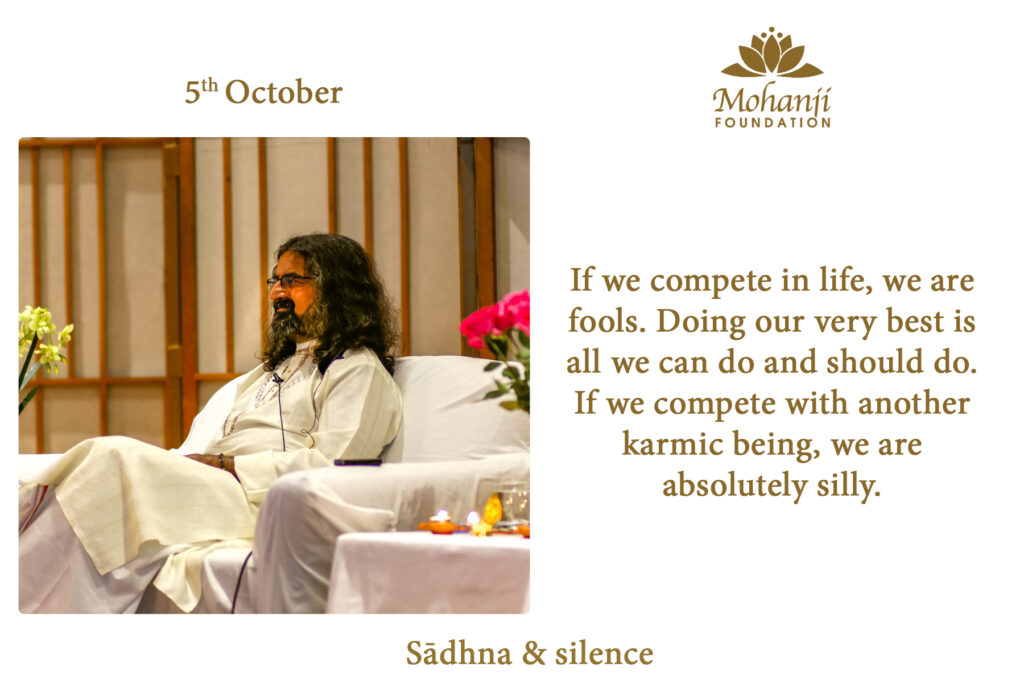
We don’t know what’s happening outside as this is the virtual world – WhatsApp, Facebook, etc., all virtual. We’re almost naked on the road because everything you do, everybody knows. Google knows everything about you, doesn’t it? Facebook knows all things about you! It’s almost like we’re not wearing any clothes. You know there’s nothing to hide. This is our situation. This is our world; accept it. Don’t try to resist it, but use your time to be in nature, be with your favourite deity, God, or Baba, whoever you’re connecting with. Spend time with their energies which are beyond.
Kaliyuga and consciousness
Please remember one thing. When Krishna left his body (when Dwaparayuga ended), most of the divine beings of the Satyuga also reduced their presence on earth, like Agastya and all these masters. They all reduced their presence on the earth because Kaliyuga was coming in.
What’s the nature of Kaliyuga? Unconsciousness. People boast about everything, even knowledge, degrees and everything. In the bargain, they lose themselves. They hold on to things which are unnecessary. Consciousness level has dipped to the level of the unconscious. From unconscious to conscious, we have to strive to get it. Our priority must be set right, and when we decide we’ll attain it, we’ll achieve it.
The advantage of Kaliyuga – if you set your priority, “I must attain liberation in this life”, then you’ll attain it. Nobody can stop you because it’s a very fast-forward lifestyle. You’ll get it, but we need to set our priorities right, and we can’t have multiple priorities, “Oh, I must have a house. I must have a car and this, but also I want liberation,” because the pattern pulls you back.
What does pattern pull you to? It pulls you to what the senses can connect to. The pattern always uses your senses, eyes, ears, nose, and mouth; it pulls you back. So, you need to keep the priority. Your actions should contribute to that priority consistently, and then accepting yourself is enough – that whatever happens in society, let it happen. It will not touch you, and even you can use it. You can use your WhatsApp and Facebook with no problem as long as it’s not making you a slave. So, you’re free.
Being practical – one word is being practical. What’s the Bhagavad Gita all about? Being practical. What’s Krishna’s life all about? It’s about being practical. He left a message before he left. Kaliyuga is coming, so it’s fundamental to be practical before being spiritual. Spirituality should not be an escapism; it should be a recognition. You should know that there’s a spirit inside, and you’re recognizing that spirit. You’re enjoying that spirit, accepting it, and even being aware of and experiencing the spirit.
That’s spirituality in Kaliyuga, especially, and that’ll make you rise higher, much more than you can ever think of. Thank you so much.
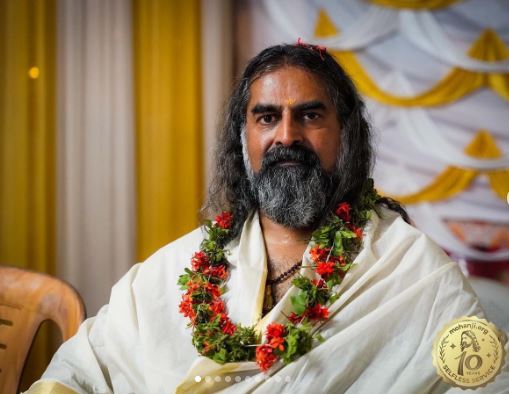
It’s fundamental to be practical before being spiritual. Spirituality should not be an escapism; it should be a recognition.
– Mohanji
Bhakti Yoga
Question: Why is Bhakti Yoga the toughest?
Mohanji: Ego. Bhakti Yoga is the toughest path because there’s ego. ‘Me and Him’ doesn’t work. ‘Me’ has to become ‘Him’. One of the greatest Bhakti Yogi is Hanumanji, right? Hanumanji never ever made himself the most important thing. He always said, “Ram is more important; I’m not important”. So, when you dissolve yourself and be at the feet of the Lord, you don’t have ego; you have no separation. The ego separates us from God. When you’re surrendered to God, there’s no separation. As long as the ego and personality come in front, Bhakti Yoga is tough, clear?
Thank you once again; enjoy the rest of the day and the rest of your life. Hopefully, we’ll meet again; we’ll be in touch. We’re all one family, the Mohanji family, so always connect and remember. All you need is to remember – one consciousness; it talks.
Thank you. Lots of love.
Watch the satsang here.
Read part 1 here.
Transcribed by Sandra Sankar
Proofread by Padmini Ravikumar and Geetha K. Suryanarayan

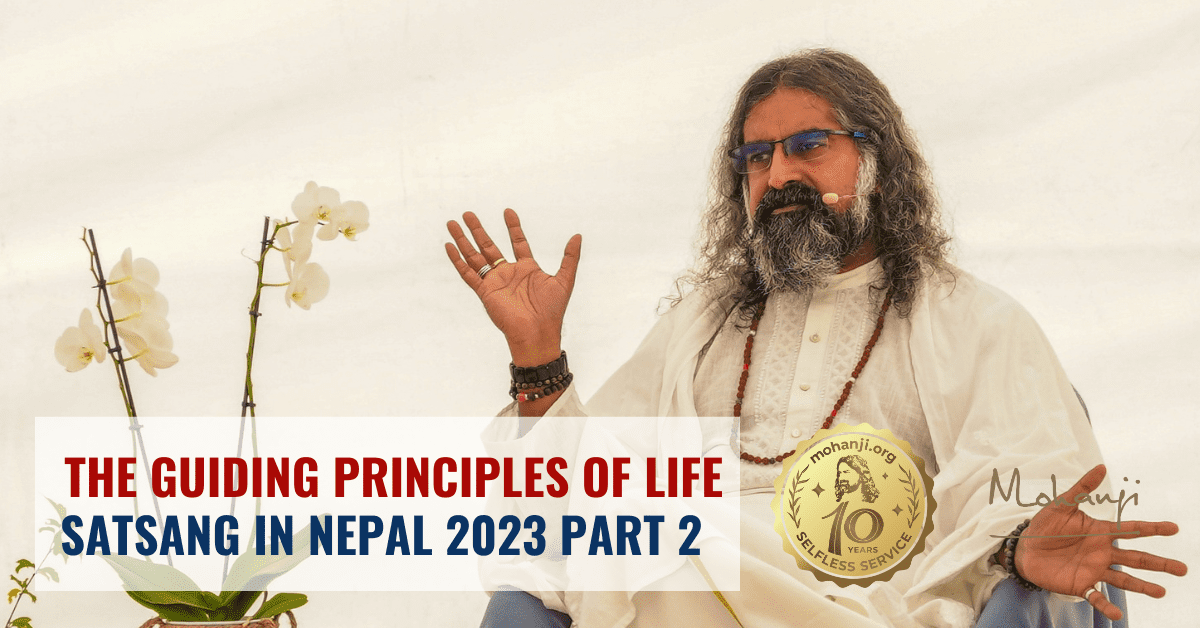
1 thought on “The guiding principles of life: Satsang in Nepal 2023: part 2”
Deep and profound satsang thank you beloved Parabrahma swaroopa Mohanji